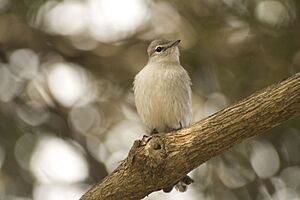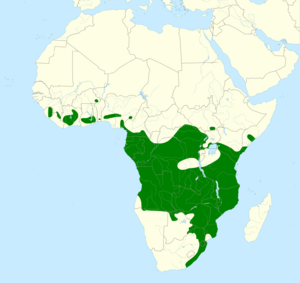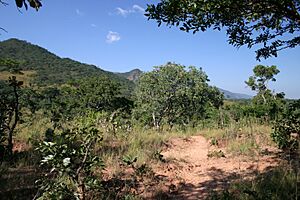Ashy flycatcher facts for kids
Quick facts for kids Ashy flycatcher |
|
|---|---|
 |
|
| Conservation status | |
| Scientific classification | |
| Genus: |
Fraseria
|
| Species: |
caerulescens
|
 |
|
| Synonyms | |
|
|
The ashy flycatcher (Fraseria caerulescens) is a small bird found in Africa. It belongs to the Old World flycatcher family called Muscicapidae. These birds live in many parts of sub-Saharan Africa, which is the area south of the Sahara Desert. They prefer places like dry or wet forests and savannas.
Ashy flycatchers are mostly grey. Their bellies are usually pale grey or white. Both male and female birds look the same. They have a small, thin, and pointed beak. This beak helps them catch insects. Their main food is insects, but they also eat berries and small lizards. These birds are very active. They search for food alone, in groups, or with other types of birds. They usually hunt for food high up in the trees. They catch insects while flying or pick them off leaves and tree bark.
Ashy flycatchers breed in pairs. Each pair protects its own area, which can be about 1 to 4 hectares big. They raise their young together. These birds make many different sounds. Their calls do not change much from one area to another.
Contents
About the Ashy Flycatcher
Naming and Classification
The ashy flycatcher was first described by a German bird expert named Gustav Hartlaub in 1865. He gave it the scientific name Butalis caerulescens. The name of its genus, Fraseria, honors an English zoologist named Louis Fraser. The word caerulescens means "dark blue" or "sky blue" in Latin. This refers to the bird's color.
The official common name for this bird is "ashy flycatcher." This name was chosen by the International Ornithologists' Union (IOU). Other names for this bird include ashy alseonax and blue-grey flycatcher.
For a long time, scientists placed the ashy flycatcher in the genus Muscicapa. However, in 2016, a study looked at the DNA of these birds. It showed that the Muscicapa group was not organized correctly. The study suggested that the ashy flycatcher is closely related to Tessmann's flycatcher. As of 2022, scientists still debate which genus is best for the ashy flycatcher. The IOU and The Clements Checklist put it in Fraseria. But the IUCN still places it in Muscicapa. More recent studies support putting it in Fraseria.
Different Types of Ashy Flycatchers
There are six recognized subspecies, or types, of ashy flycatchers:
- F. c. caerulescens: This is the original type. It lives in Mozambique, South Africa, and Eswatini.
- F. c. brevicauda: This type is found from northern Benin to South Sudan and parts of the Democratic Republic of the Congo. It is darker than the original type. Its upper parts are slate-grey, and its underparts are grey.
- F. c. nigrorum: This type lives from Guinea to Togo. It is a bit paler than brevicauda. Its upper parts are mouse-grey, and its underparts are more evenly grey.
- F. c. cinereola: This type is found in Somalia, Kenya, and Tanzania. It looks like a mix between brevicauda and impavida.
- F. c. vulturna: This type lives from Malawi and Mozambique to northern South Africa. It is paler than the original type. Its throat and belly are a purer white.
- F. c. impavida: This type is found from Angola to the DRC, Tanzania, and Mozambique. It also lives in Namibia, Botswana, and Zimbabwe. It is even paler than vulturna. Its upper parts are ashier and less blue. Its underparts are more uniformly white.
What Ashy Flycatchers Look Like
The ashy flycatcher is about 13 to 15 centimeters (5 to 6 inches) long. Adult birds of the original type have bluish-grey heads and backs. Their chins and throats are very pale grey. Their chests and sides are pale grey, and their bellies are white. They have black lines near their eyes with white stripes above them. They also have pale, clear rings around their eyes.
Their flight feathers and tail are brownish-black. The feathers covering their upper wings are brownish-black with grey edges. The feathers under their wings are white. Their beak is usually blackish, but the bottom part of the lower beak is pinkish-grey. Their eyes are dark brown, and their legs are dark grey or black. Both male and female birds look alike.
Young ashy flycatchers are brownish. They have buff (yellowish-brown) markings on their upper parts. Their upper wing feathers have buff tips, and their underparts are spotted. As they get older, they look more like adults. But they still have buff tips on their wing feathers.
Bird Calls
Ashy flycatchers are found in many places. But their calls sound very similar no matter where they live. They have many different types of calls. Their morning song, sung at dawn, has 5 to 7 notes. These notes usually start high, go down, and then go up again. They repeat these phrases every 3 to 5 times. They sing this song for at least 30 minutes from a high spot in a tree.
After the sun rises, they switch to a "day song." This song has 3 to 8 short, sharp notes. They also have a "warbling song."
Their other calls include short peeps and chirps. They also make a high-pitched wheeze. When they sense danger, they make a piercing, slightly descending hiss. This is an alarm call, similar to those of other birds. It warns others about predators. When they are scared or stressed, they make a shrill, high-pitched, buzzing sound. Male birds also snap their wings and beaks if someone gets too close to their young. Baby birds make a high-pitched begging call. This call sounds like a "shrill, short, rattling squeak."
How Ashy Flycatchers Live
The ashy flycatcher is a very active bird. It is always moving and shifting around. Sometimes, they have been seen sunbathing on the ground.
What They Eat
Ashy flycatchers look for food alone, in pairs, or in groups of up to seven birds. They sometimes join groups of different bird species while hunting. They usually search for food in the upper parts of trees, from the treetops down to the lower branches.
These birds often sit upright on open branches. They catch food by flying short circles to grab insects in the air. They also hover to catch prey from leaves. They can also pick insects off leaves and tree bark.
Their diet is mostly insects. They eat beetles, flies, grasshoppers, and adult and young moths and butterflies. They also eat winged ants and termites. The insects they eat are usually 5 to 35 millimeters (0.2 to 1.4 inches) long. Most of them are 15 to 20 millimeters (0.6 to 0.8 inches) long. They have also been seen eating small fruits and berries. Rarely, they eat geckos up to 5 centimeters (2 inches) long.
Raising Young
Ashy flycatchers mainly breed from September to January. The exact breeding time can change depending on the area. They have also been seen breeding in other months, like February to June in the DRC.
Pairs are monogamous, meaning they stay with one partner. They are solitary and protect their own areas. They keep territories of 1 to 4 hectares during breeding season. Nests are usually built 2 to 15 meters (7 to 49 feet) high. They build them in cracks, holes, or forks in trees. Sometimes, they use holes or ledges in walls.
Both male and female birds build the nest. It is a strong cup made of moss, grass, roots, shredded bark, fibers, and spiderwebs. The nest is about 11 to 18 centimeters (4 to 7 inches) wide on the outside. The inside is about 45 to 50 millimeters (1.8 to 2 inches) wide and 25 to 28 millimeters (1 to 1.1 inches) deep. Birds have been known to build over old nests. They also sometimes use old weaver bird nests.
The eggs are about 19 by 14.5 millimeters (0.75 by 0.57 inches) in size. They are shiny whitish-buff with yellowish-brown or reddish spots. Females lay 2 to 3 eggs at a time. The eggs take 14 days to hatch. After the young birds hatch, both parents feed them.
Where Ashy Flycatchers Live
The ashy flycatcher lives in most of sub-Saharan Africa. This includes areas from southern Cameroon to southern Kenya and Somalia. It also extends south to Angola, northern Namibia, Botswana, and eastern South Africa. They are not found in the very dry parts of Namibia, Botswana, and South Africa.
They are found in some parts of West Africa. This includes Sierra Leone, Liberia, Côte d'Ivoire, and southern Nigeria. Most ashy flycatchers stay in one place. But some in the southern parts of their range move a little. In South Africa, they sometimes move to different altitudes in the Great Escarpment. They are also thought to be non-breeding migrants in Mozambique.
These birds live in many kinds of forests and woodland. They prefer forest edges and only go into forests if they have been cut down or opened by roads. They also live in open forests along rivers, new forests that are growing back, and some plantations. They can be found in fields with scattered tall trees and bushes. They also live in miombo woodland, dense thickets, and open woodlands along rivers. They usually live at altitudes up to 1,500 meters (4,900 feet). But in eastern Africa, they can be found up to 1,800 meters (5,900 feet) high.
Conservation Status
The International Union for Conservation of Nature (IUCN) lists the ashy flycatcher as a species of least concern on the IUCN Red List. This means it is not currently at risk of disappearing. This is because it lives in a very large area. Its population is stable, and it lives in many protected areas. In Mozambique, there are estimated to be over 5,000 ashy flycatchers.





